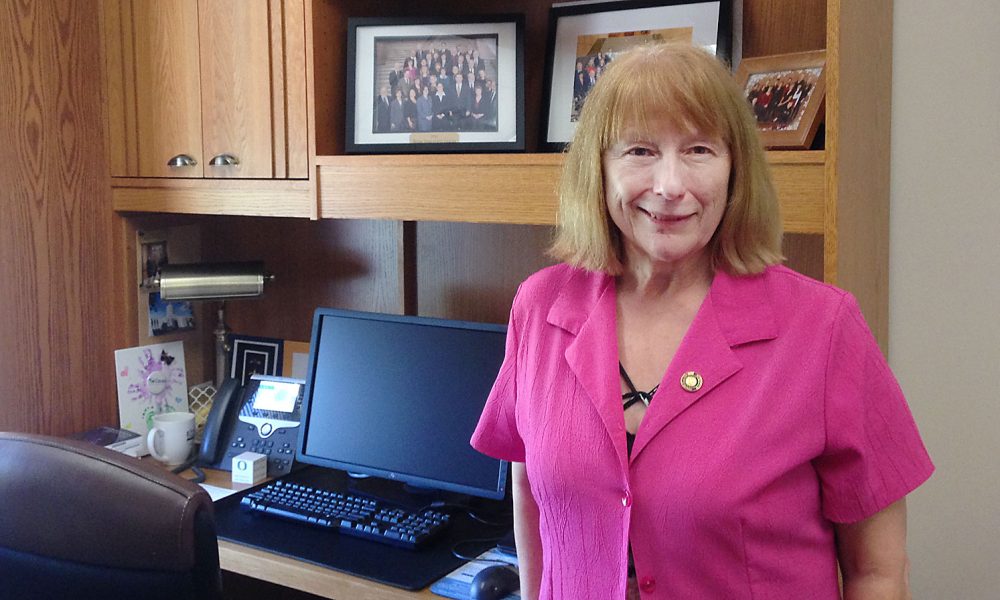
State Rep. Susan McLain, D-Forest Grove, says work on regulating driverless cars will take years. (Claire Withycombe/Oregon Capital Bureau)
SALEM — As development of driverless cars accelerates, Oregon is trying to catch up.
The state has no regulation for what are termed autonomous cars. The law assumes there’s a person behind the wheel.
“It felt like ‘The Jetsons’ to them,” said Sarah Kelber, a spokeswoman for the Oregon Department of Transportation. “That wasn’t even in anybody’s mindset when the vehicle code was written.”
The federal government regulates vehicle manufacturing and safety standards.
But states oversee licensing, registration and traffic laws — areas where driverless cars are also poised to have a significant impact.
Many of the open questions concern who is responsible when something goes wrong.
For example, if a car in fully automated mode crashes, who files a report — the manufacturer, the owner, or an operating company? Do distracted and impaired driving statutes apply, and to whom?
And the law is mum on whether individual owners or manufacturers should be liable for software updates.
National attention trained on the issue of culpability earlier this year, when a 49-year-old pedestrian was struck and killed in March by an autonomous vehicle in Tempe, Arizona.
In a June report, Tempe police said the crash was avoidable. The car’s “safety driver” — essentially a human back-up for the self-driving technology —had been streaming a TV show at the time of the crash.
Earlier this month, an Oregon task force recommended the state’s first governance for testing of autonomous vehicles on public roads.
These ranged from requiring that the vehicles display a special decal to requiring insurance.
As of May, two companies, Daimler and Intel, had reported plans to test autonomous vehicles to the Oregon Department of Transportation. But the agency has no regulatory authority over autonomous vehicle testing.
Lt. Timothy Tannenbaum of the Washington County Sheriff’s Office, who chaired the task force, told state lawmakers on Wednesday that the group didn’t have enough time to write recommendations for “deployment” — when people or companies start using automated cars or trucks for personal or business purposes.
Some worry that focusing on testing means Oregon could fall behind when it comes to rules for consumer use of such vehicles.
“The industry is deeply concerned that the adoption of AV testing-only policies would continue to keep Oregon far behind in realizing the potential positive benefits of AVs to safety, congestion relief, and transportation equity,” wrote Jon Isaacs, public affairs manager for Uber and a member of the task force, in comments on the report.
“The regulatory framework for testing partially lays the groundwork for AV deployment, but Oregon needs comprehensive deployment policies to address the issues that matter to Oregonians, such as safety, congestion, job opportunities and equitable access to transportation,” wrote representatives of the City of Portland, Metro and TriMet in joint comments on the report. “The state needs to take action well before AVs are deployed at scale.”
They added that they think that the state could collect more information on testing than the recommendations specify.
“To evaluate the safety of AVs, Oregon needs to know not just where and how collisions occur, but also where and how AVs are being tested in order to understand the risks that AVs pose relative to other modes,” they wrote. “Other states require additional data from AV tests for this reason. We believe Oregon should follow suit, and make test data available to inform policymaking in a way that protects the trade secrets of companies that test AVs.”
State Rep. Susan McLain, D-Forest Grove, who chairs the House Committee on Transportation Policy, said she is reluctant to move too quickly with such a complex issue.
The task force plans to continue meeting, but it may be a couple of years before deployment rules are proposed in a bill.
“I think that you will see something in that 2021 timeframe that definitely makes sure that industry can get to the level and the type of deployment that they think is necessary,” McLain said.
McLain emphasized crafting a state policy that can get updated as technology advances, and as the composition of vehicles on the road changes.
“I don’t think it’s taking long at all when you’re talking about 40 years worth of work, to be honest,” McLain said. “This is not going to be once and done.”
Reporter Claire Withycombe: [email protected] or 503-385-4903. Withycombe is a reporter the EO Media Group working for the Oregon Capital Bureau, a collaboration of EO Media, Pamplin Media Group, and Salem Reporter.









